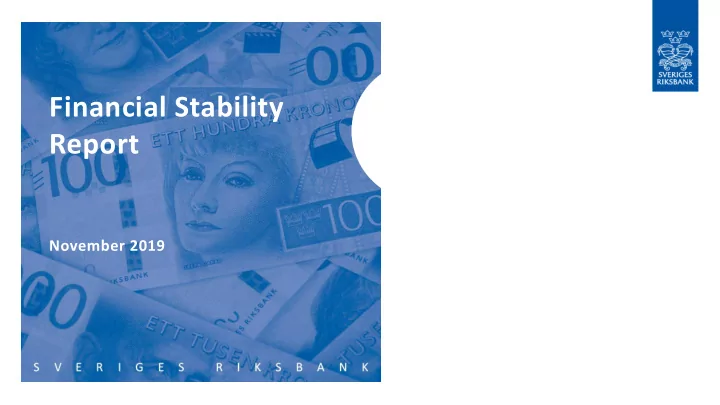

Financial Stability Report November 2019
The risks to financial stability in Sweden are slightly greater than in the spring
Economic slowdown and continued low interest rates Weaker growth prospects Lower government bond yields GDP, quarterly changes in per cent calculated as an annual rate. Yields on 10-year government bonds, per cent. Sources: Bureau of Economic Analysis, Eurostat, Statistics Sweden Sources: Macrobond and the Riksbank and the Riksbank
Uncertainty abroad remains
Household indebtedness – the largest domestic risk Debt is still high... … but growing at a slightly slower rate Total household debt as a share of disposable household income added Credit growth, annual percentage change. Refers to loans from monetary together over the last four quarters. The dashed line represents the financial institutions (MFIs). Riksbank’s forecast. Sources: Statistics Sweden and the Riksbank
Problems on the housing market need to be managed • Housing prices have stabilised, but uncertainty remains • The housing market functions poorly • Important that tax and housing policy manage the problems – sporadic measures not enough Housing prices in Sweden, index 2005=100. Housing prices are seasonally- adjusted. Sources: Statistics Sweden, Valueguard and the Riksbank
There are vulnerabilities in the banking system • Large banking system, high degree of interconnectedness • Swedish banks have substantial exposure to housing and commercial property 76% • Dependent on wholesale funding and exposed to liquidity risks The chart refers to the percentage share of lending from Monetary Financial Institutions to households and companies that is against collateral in property. Source: Statistics Sweden
Banks’ liquidity in SEK has increased 120 120 100 100 80 80 60 60 40 40 20 20 0 0 Lowest single observation Liquidity Coverage Ratio in SEK (LCR), per cent. Source: The Riksbank
Stress tests of banks’ liquidity • The Riksbank has stress-tested banks’ liquidity • Liquidity needs increase rapidly if stress continues for more than a month • The banks have substantial liquidity needs after 6 months • Important that banks extend the maturity of their funding and maintain enough liquidity reserves in all their significant currencies
Infrastructure needs to increase its resilience • Specific measures in individual companies • Internationally, cyber risks are seen as one of the greatest threats • Structural changes on the payment and securities markets
Climate change can create financial risk • Important that the financial system has resilience to climate-related risks • Must be possible to measure, price and manage climate risks • Financial corporations should disclose their climate-related risks and opportunities (possibilities?) • A global challenge demands international cooperation
The risks to financial stability in Sweden are slightly greater than in the spring
Recommend
More recommend